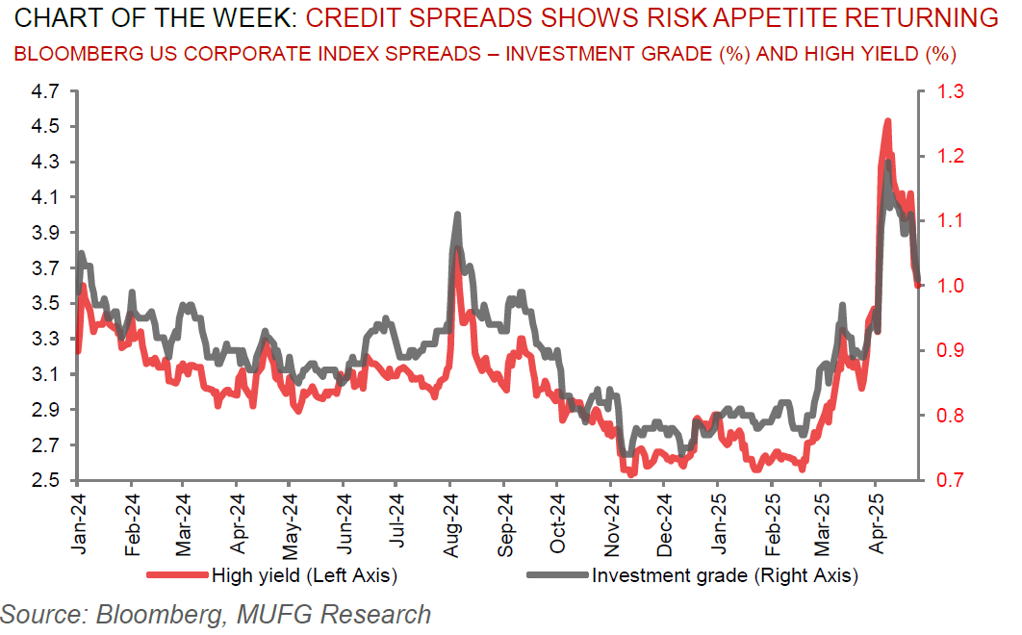Where is the consensus on EM post IMF/World Bank Spring meetings?
EHSAN KHOMAN
Head of Commodities, ESG and
Emerging Markets Research –
EMEA
DIFC Branch – Dubai
T:+971 (4)387 5033
E: ehsan.khoman@ae.mufg.jp
SOOJIN KIM
Research Analyst
DIFC Branch – Dubai
T: +44(4)387 5031
E: soojin.kim@ae.mufg.jp
LEE HARDMAN
Senior Currency Analyst
Global Markets Research
Global Markets Division for EMEA
T: +44(0)20 577 1968
E: lee.hardman@uk.mufg.jp
MUFG Bank, Ltd.
A member of MUFG, a global financial group
Macro focus
As we approach the 100-day milestone of President Trump’s second term, sentiment during the IMF/World Bank spring meetings last week was categorically bleak. The downturn in sentiment is a striking reversal in sentiment compared to the 2024 IMF/World fall meetings, which occurred immediately before the November 2024 US presidential and congressional elections (with optimistic consensus narratives on the global economy at the time – irrespective of the US election outcome). Last week, the IMF lowered its global GDP growth forecasts for 2025 by a sizeable 0.5ppts to 2.8% and in 2026 by 0.3ppts to 3.0%. Meanwhile, global inflation was notched up by 0.1ppts for both 2025 to 4.3% and 2026 to 3.6%. The market consensus is singing from the same hymn sheet as the IMF in sharing its concerns. Granted, the recent US reconciliatory tone towards China surrounding its tariff policy is encouraging but the downside risks to the global economy are growing amid a reconfiguration of the global trade order and high policy uncertainty. Our reading of the outcomes from the plethora of meetings that took place last week in Washington is that the broad consensus expects the global economy to enter a stagflationary period – portmanteau of stagnant economic growth and elevated inflation – over the next 12 months. For EMs, we ask where to play to win (and hide)? The list of EMs is not long, in our view.
FX views
It has been a more mixed week for EM FX performance. LatAm currencies have benefitted from building investor optimism that President Trump will take action in the coming months to further reverse more disruptive tariff hikes especially on China where the current 145% tariffs are judged to be “unsustainable”. Within EMEA FX, the recent underperformance of the PLN continues to stand out. The PLN has been undermined recently by the dovish repricing of the outlook for NBP policy. Market speculation over NBP rate cuts as soon as next month have been encouraged by comments from NBP officials who are weighing up whether to deliver a larger 50bps rate cut to start the easing cycle.
Week in review
Saudi Arabia has published its annual report into progress made nine years following the launch of Vision 2030 – the comprehensive report of the progress achieved by the 13 vision realisation programmes highlights that 93% of the 374 indicators for 2024 have either been successfully completed or are on track to meet their targets. S&P downgraded Bahrain’s sovereign outlook from stable to negative, reflecting increased risks to the fiscal position and the government’s ability to service and refinance debt. Headline inflation in South Africa fell from 3.2% y/y in February to 2.7% y/y in March, led by core prices. The Central Bank of Russia (CBR) maintained its key rate at 21.00%, in line with our (and consensus) expectations, but emphasised a tight monetary policy.
Week ahead
It will be a broadly busy week across EM EMEA. The National Bank of Hungary (MNB) will host a monetary policy meeting on 29 April (MUFG and consensus: on hold at 6.50%). Flash Q1 2025 estimates for Hungary (MUFG and consensus: steady at 0.4% q/q) and Czech Republic (MUFG and consensus: up 0.2ppts to 2.0% y/y) will be released. What’s more, flash CPI estimates will be released for Poland (MUFG and consensus: -0.7ppts to 4.2% y/y). Finally, there will be the first round of the (re-run) Presidential elections in Romania (4 May).
Forecasts at a glance
The external backdrop for EM has shifted abruptly – the soft-landing pro-risk environment and pricing of non-recessionary Fed cuts has given way to concerns around tariff risks (and likely retaliatory action), higher-for-longer US rates and a strong US dollar. This sets the stage for a challenging EM backdrop in 2025. There are dimensions that could make Trump 2.0 less disruptive. Given the reduced direct trade exposure of the Chinese economy to the US and expectations that there will be a monetary and fiscal response by Chinese policymakers to offset the tariff growth shock, the economic and financial market disruptions will, on aggregate, be less severe than Trump 1.0.
Core indicators
The latest weekly IIF flow data signalled that EM securities witnessed inflows of USD3.4bn in the week ending 25 April. The breakdown suggests that equities inflows reached USD2.0bn and debt inflows USD1.3bn, showing a relatively balanced recovery across asset classes.

